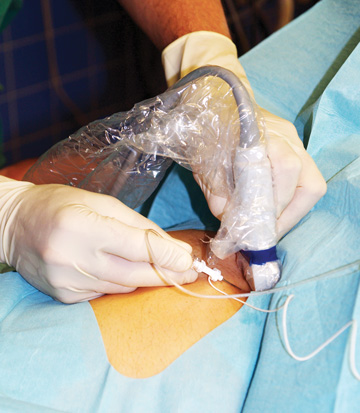• Equipment essentials. Ultrasound machines are a must to help anesthesia providers place targeted blocks. “Depending on case volume, you need at least one ultrasound machine and a minimum of three probes per machine —
a high-frequency linear probe, a low frequency curvilinear probe and a large low-frequency probe for abdominal and hip blocks,” says Dr. Kumar. She adds that facilities also need 30ml syringes, block needles, extension tubing and
stopcocks, as well as supplies such as chlorhexidine gluconate (CHG) prep sticks, gauze, nerve stimulators, EKG leads and a variety of local anesthetics.
Providers must also have access to the latest patient monitoring technology. Dr. Kumar says standard monitoring includes ETCO2 modules, nasal cannulas for oxygen monitoring — including ETCO2 sampling capability — a Local Anesthetic
Systemic Toxicity (LAST) rescue kit, and suction and intubating equipment. These items should be kept on a nerve block cart that is immediately accessible to providers.
• Specialized staff. Outfitting your facility for regional anesthesia is one thing, but working with skilled and experienced anesthesia providers is just as important. Providers must be well-versed in using ultrasound guidance
to place the latest nerve blocks (see “Must-Know Nerve Blocks”). “Many anesthesiologists today have extensive subspecialty training in regional anesthesia,” says Jinlei Li, MD, PhD, FASA, incoming vice chair
of the American Society of Anesthesiologists’ Committee on Regional Anesthesia and Acute Pain Medicine and director of regional anesthesiology at Yale New Haven (Conn.) Hospital.
She adds that a nurse anesthetist and a block nurse coordinator play critical roles in the success of a regional program. The latter, she says, is particularly valuable in the fast-paced ASC environment. At her facility, when anesthesiologists
perform regional anesthesia, block nurse coordinators help with everything from monitoring and communicating with patients to increasing or decreasing sedation levels, providing oxygen and documenting each block performed to provide a
resource if patients have follow-up questions or concerns about their recoveries. “This is a good way to keep a record of what blocks are performed for specific patient populations,” says Dr. Li. “It’s also key
for quality control purposes.”
• Managing workflows. Nerve blocks should be placed preoperatively in a dedicated procedural area before patients are brought to the OR in order to maintain patient flow and clinical efficiencies. There are several preparational,
administrative and educational challenges to making sure that happens. “One of the major obstacles to efficiency in nerve block placements is patients who aren’t informed ahead of time about what to expect in terms of anesthesia
or pain management and who aren’t receptive to having blocks administered on the day of surgery,” says Dr. Kumar.
She adds that other barriers to efficient block placement include staff not being on the same page with respect to regional techniques, workflow and expected effects of the blocks as well as how to handle inevitable disruptions to surgical
routines — patients or surgeons running late, surgeons who didn’t complete their part of the pre-op block workflow on time and inadequate staff available to help position the patient.
.svg?sfvrsn=be606e78_3)

.svg?sfvrsn=56b2f850_5)